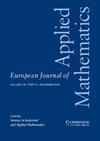Special Issue of EJAM: The Mathematics in Renewable Energy
IF 1.1
4区 数学
Q1 MATHEMATICS, APPLIED
引用次数: 0
Abstract
The conversion, storage and distribution of energy from renewable sources drive some of the most inno-vative technologies with the goal to meet global energy demands and to mitigate climate change. For instance, research in photovoltaics, which combines materials science, device modelling and optics, has seen intensive growth in all areas and on all relevant scales during the past decades. The role of mathematics has been key to understand and develop novel optimised photovoltaic devices. However, while the global cumulative solar capacity is growing fast, the temporal variability of photovoltaic or wind-generated electricity from intra-day to seasonal scales constitutes a major obstacle for matching demand. Energy storage plays a major role in addressing this problem, for example via large-scale stationary battery systems, or photochemical hydrogen production. Most importantly, the growing complexity of power distribution across coupled distribution grids constitutes perhaps the hardest current challenge. Apart from setting up the infrastructure, monitoring and planning, these increasingly complex networks pose difficult mathematical problems, relating to fluctuations in coupled energy networks, that are also impacted by market regulations. The focus of research articles in this special issue of the European Journal of Applied Mathematics presents some of the mathematical challenges encountered in the prediction of power grid responses on different temporal and spatial scales and to various types of disturbances. In particular, contributions to the special issue report findings on coupled energy networks composed of gas and electric power networks of realistic size, that are coupled to stochastic fluctuations due to fluctuating demands and supplies. Others address the stability of electrical power grids, develop guiding principles for power grid operation, control and design, and perform case studies on optimisation of energy generation, taking into account sustainability goals for 2050 in Europe, under uncertain future market conditions. In addition, a modelling framework that enables researchers to quantify degradation effects of lithium-ion battery cells and a new approach to model parabolic trough power plants are presented. Such complex problems require a broad spectrum ofEJAM特刊:可再生能源中的数学
可再生能源的转换、储存和分配推动了一些最具创新性的技术,其目标是满足全球能源需求并减缓气候变化。例如,结合材料科学、装置建模和光学的光电研究在过去几十年中在所有领域和所有相关规模上都有了密集的增长。数学的作用是理解和开发新型优化光伏器件的关键。然而,虽然全球累积太阳能发电能力增长迅速,但从日间到季节性的光伏发电或风力发电的时间变化是满足需求的主要障碍。能量储存在解决这个问题上起着重要的作用,例如通过大规模的固定电池系统,或光化学制氢。最重要的是,跨耦合配电网的电力分配日益复杂,这可能是当前最严峻的挑战。除了建立基础设施、监测和规划之外,这些日益复杂的网络还带来了与耦合能源网络波动有关的困难的数学问题,这些波动也受到市场规则的影响。这期《欧洲应用数学杂志》特刊的研究文章重点介绍了在预测不同时空尺度和各种类型干扰下电网响应时遇到的一些数学挑战。特别地,特刊的投稿报告了关于由实际规模的燃气和电力网络组成的耦合能源网络的调查结果,这些网络由于需求和供应的波动而与随机波动相耦合。其他研究则涉及电网的稳定性,制定电网运行、控制和设计的指导原则,并对能源生产的优化进行案例研究,在不确定的未来市场条件下,考虑到欧洲2050年的可持续发展目标。此外,还提出了一个建模框架,使研究人员能够量化锂离子电池的降解效应,并提出了一种新的方法来模拟抛物线槽发电厂。如此复杂的问题需要广泛的知识
本文章由计算机程序翻译,如有差异,请以英文原文为准。
求助全文
约1分钟内获得全文
求助全文
来源期刊
CiteScore
4.70
自引率
0.00%
发文量
31
审稿时长
>12 weeks
期刊介绍:
Since 2008 EJAM surveys have been expanded to cover Applied and Industrial Mathematics. Coverage of the journal has been strengthened in probabilistic applications, while still focusing on those areas of applied mathematics inspired by real-world applications, and at the same time fostering the development of theoretical methods with a broad range of applicability. Survey papers contain reviews of emerging areas of mathematics, either in core areas or with relevance to users in industry and other disciplines. Research papers may be in any area of applied mathematics, with special emphasis on new mathematical ideas, relevant to modelling and analysis in modern science and technology, and the development of interesting mathematical methods of wide applicability.

 求助内容:
求助内容: 应助结果提醒方式:
应助结果提醒方式:


